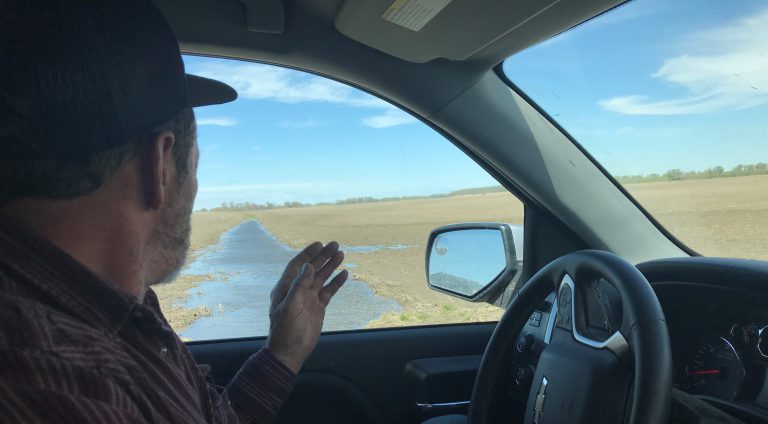The Missouri River swamped Scott Olson’s land in March — the second time in the last eight years. Flooding tore holes in his fields and left mounds of debris. He’s not entirely sure he’ll plant corn and soybeans this season on the flooded acres.
NET News reporter Allison Mollenkamp traces the challenges that farmers have in the wake of spring flooding.
“How do you fix that stuff? It takes a lot of money and a lot of time, and something nobody has. Time maybe, but not the money anymore,” said Olson, who lives north of Omaha, Nebraska.
“So do I fix it, and try to plant it, not knowing whether I’ve got more water coming or not? Cause if I get more water coming on there, it’ll undo everything I did, plus wipe out all the crop that I just put on there,” he added.
It’s a decision farmers across the Midwest — especially in Nebraska, Iowa, Missouri and Illinois — will have to make as planting season is in full swing. Many areas are getting consistent heavy rains, which means losing valuable time in the field. Flooding is also making transporting grain more difficult, and when it comes time for harvest, commodity prices may still be low.
And for those like Olson, along the still-flooded Missouri and Mississippi rivers, flood cleanup is one more layer of difficulty. Out in the fields in his pickup, Olson pointed to one of three large scour holes — areas where floodwater eroded large amounts of soil.
“If I could run 12 hours a day, it would take me two weeks to get this one filled up and leveled out so my drainage and stuff, if I was lucky,” Olson said.
He also has debris on his fields, including thick layers of corn stalks pushed up by flooding.
“I’ve got some that’s two- and three-feet deep. The ground is wet underneath. It’s dry on top. We burn it off. We’ll go back with a four-wheeler and a harrow section because the tractor’s too heavy and it’s too mucky underneath,” he said, adding, “I’ve got places I’ve burnt four times already and I still have two feet of debris down there.”
Economic impact
But it’s not just corn stalks piling up. There’s dead livestock, tree limbs and tanks, according to Kelly Brunkhorst, the executive director of the Nebraska Corn Board.
He said there likely will be fields that will go unplanted this year because the time and resources aren’t available to get them ready for crops. That will have a significant economic impact in Nebraska, let alone in other states that were affected by flooding.
“We, along with the Department of Ag, took the lead in regards to estimating that sort of probably about $440 million worth of crop damages because of, as we look into 2019, unplanted crops, late planting, stuff like that that’s gonna happen this year,” Brunkhorst said.
In northwest Missouri, near St. Joseph, Jeff Gaskill had planted only about a third of his usual crop by early May. He said he’s worried that might be it for the year, because some of his land is underwater. And the rain just keeps coming.
“A lot of the lower ground and anything within a third of the mile of the river, you just can’t get on it because the river’s still two feet above flood stage,” Gaskill said.

Even farmers looking to sell last year’s grain are impacted by flooding.
Mike Steenhoek is the executive director of the Soy Transportation Coalition, which is based in Iowa. He said grain handlers can’t move product due to flooding along railroads and rivers, so “they discourage farmers from making these deliveries by lowering the price that they offer for a bushel of soybeans or corn or other commodities.”
Olson shares the concerns of the governors of Nebraska, Iowa and Missouri: that ag has been harmed not just by nature, but also by the Army Corps of Engineers.
“Congress needs to change the way things are done,” he said. “The Corps needs to get back control of the river and put flood control back as Number One priority.”
At a meeting last month, Corps representatives said they did what they could to prevent flooding with the storage they have in reservoirs. But whether the recent flooding changes how the Corps handles flooding, Olson and other farmers are dealing with the second large flood in 10 years.
“We’re working a lot of ground we don’t usually have to work because of that so we’re spending more money trying to get a crop in. Every place I turn around, I’ve gotta do something different,” he said. “But I’m not giving up.”
Allison Mollenkamp is a reporter with Harvest partner NET News. Reach her on @allisonmollenk1


